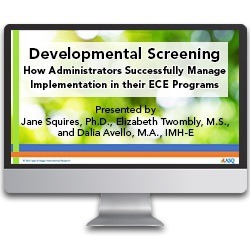We hope you enjoyed the webinar Developmental Screening: How Administrators Successfully Manage Implementation in their ECE Programs presented by Jane Squires, Ph.D., Elizabeth Twombly, M.S., and Dalia Avello on April 28, 2021.
In this Q&A, we’re diving into the questions from listeners that we didn’t get to cover in the live webinar.
Q: Do you recommend using a screening tool like ASQ along with an observation/assessment tool? Or is using the ASQ enough?
Screening has a specific purpose—to identify which children appear to be developing typically, and which should be seen for a further look because of parent concerns and/or skills on the screening below their expected age. Usually, observation/assessment tools are used for programmatic information—figuring out where a child is in their language, reading, and social interactions—so that you can fit your curriculum to their current level and needs. That said, there is sometimes overlap in these two forms of assessment. For more about the differences between screening and assessment, see this infographic.
Q: Do you recommend a teacher complete ASQ-3 in addition to the parent completing it?
Having both the teacher and parent complete a questionnaire is something the program would need to determine. Oftentimes, there are not enough time and other resources for both parents and teachers to complete the same ASQ. Most important is that the parents and teachers talk about the child’s skills (as assessed by ASQ-3 completed by parent and/or teacher, as well as observations from both in different settings) and parent concerns and decide on steps for follow-up. Follow-up could include referral for further assessment, re-screening in 3–4 months, or completing the next ASQ interval on schedule.
The beauty of ASQ is that it can serve as a springboard for conversations between parent and teacher and be a step towards building relationships and trust between them.
Q: Can you give an example of how ASQ-3 and ASQ:SE-2 provides for cultural adaptations?
The ASQ items can be modified as needed to account for cultural differences, as long as the targeted skill (item intent) is obtained. See two examples below. And get more information about adapting items and materials in this guide.
- Instead of pencils or crayons, children can make letters or shapes in wet sand with a stick.
- Any items that children play with at home can be used for “toys”—rocks, boxes, twigs, etc.
Also, if items are not culturally appropriate for a child and family, up to 2 items per area for ASQ-3 and up to 3 items for ASQ:SE-2 can be omitted and adjusted scoring used. See examples where omitting an item may be appropriate below.
- If children eat with their fingers, items about forks/spoons can be omitted.
- If parents don’t want their child looking at mirrors, mirror items can be omitted.
Read this article for more on using ASQ with diverse families. And use our free ASQ Calculator app to easily calculate adjusted scoring when omitting items.
Q: What languages are available for ASQ-3 and ASQ:SE-2?
ASQ-3 is currently available in Arabic, Chinese (Simplified and Traditional characters), English, French, Spanish, and Vietnamese. ASQ:SE-2 is currently available in Arabic, English, French, and Spanish.
ASQ-3 in Russian, ASQ:SE-2 in Vietnamese, and ASQ:SE-2 in Chinese are currently in development and expected to be available in 2022.
Additional languages are available to license. See our Translations of ASQ page for more information.
Q: What is the best way to implement ASQ in a child care setting using ASQ Online? For example, does using only Family Access change the results? How can we ensure that parents have tried the skills/activity before answering?
Giving parents and caregivers the option to complete ASQ questionnaires electronically through ASQ Family Access can be convenient for both families and child care staff. However, centers should also support families that wish to complete questionnaires on paper for a variety of reasons (for example, lack of internet access, unfamiliarity with technology, language or reading difficulties).
Your introduction to parents about the concept of screening and ASQ can help ensure that parents try ASQ-3 items prior to answering. In your letter, email, or conversation, let parents know that it’s important to try the items. And explain that completing ASQ should be a fun activity for the family. Consider sharing the ASQ-3 Parent Guide and the Materials Needed to Administer ASQ-3 handout with families.
Several years ago, we conducted research on electronic versus paper completion of ASQ questionnaires and found few differences how items were scored. More information can be found in the 2013 journal article, Adaptation from Paper-Pencil to Web-Based Administration of a Parent-Completed Developmental Questionnaire for Young Children.
Q: Do people need to be trained to use ASQ-3 or ASQ:SE-2?
Training is not required to use the ASQ screening tools. The User’s Guides have detailed information about implementing a screening program, scoring questionnaires, interpreting results, and determining appropriate follow-up. Information is also available in the ASQ Training Portal (free registration required).
Many programs do find training helpful in ensuring an effective screening program. We offer ASQ training DVDs, as well as virtual training from our Brookes on Location program. Learn more.
Q: Where can we find training for ASQ?
There are some introductory training materials available on www.agesandstages.com, including an Introduction to ASQ-3 presentation and Introduction to ASQ:SE-2 presentation. The ASQ training DVDs are also a helpful resource.
Live virtual training is also available through Brookes on Location, our professional development program. Learn more.
Q: When will ASQ-4 be released?
Although publication of ASQ-4 is still 18–24 months away, the developers are well on their way to making the trusted screening tool even more useful. The data collection phase has concluded, and information is currently being analyzed. After data analysis, next steps include making final revisions and production.
For more information about the new edition, visit our ASQ-4 FAQ page.
Get the slide handouts and other resources shared during the webinar
-

What ASQ Users are Saying
“ASQ-3 has helped make our staff and our families more aware of developmentally appropriate growth and development. The resources that come with the ASQ-3 have been instrumental for parents to provide school readiness activities at home and to understand the objectives that we cover in our plans.”
Jessica Trail, Head of Faculty & Administration, The Young School


